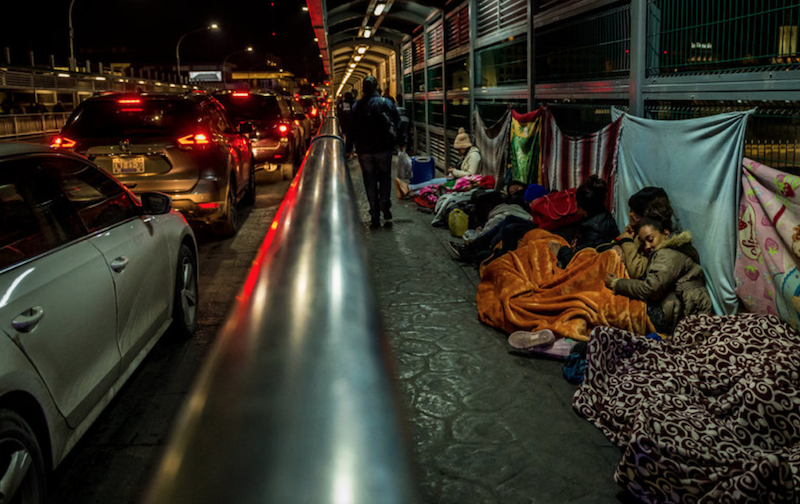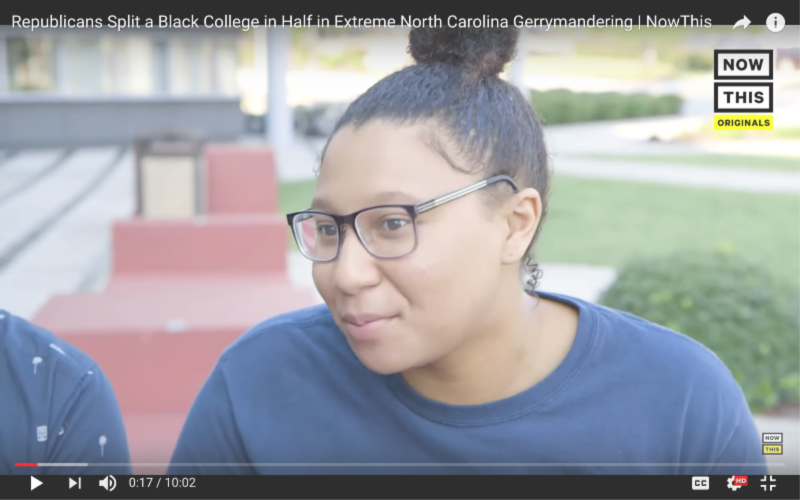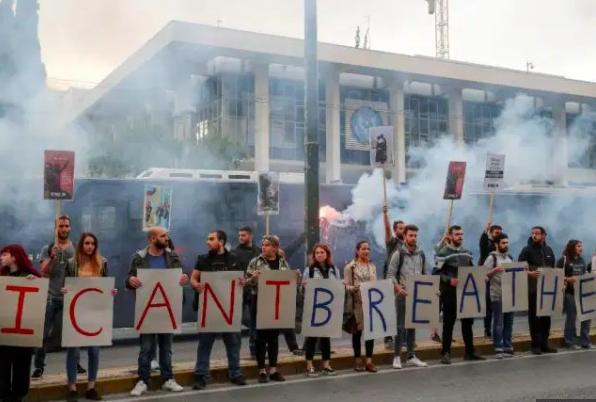New York Times: Along the U.S.- Mexico Border
Source: New York Times – Confluence Daily is your daily news source for women in the know.
As the president fights to build a wall between the United States and Mexico, the journalists Azam Ahmed and Meridith Kohut are driving along the approximately 1,900-mile border and sending dispatches.
Goods flow freely. People?
That’s another story.
NUEVO LAREDO, Mexico – Thirteen thousand trucks a day. A million dollars a minute.
That, on average, is the value of the cargo that crosses the border between Laredo and Nuevo Laredo on the United States-Mexico border.
Here, between the two Laredos, the border is booming. Trucks loaded with everything from car parts to packaged food hum across a bridge that has been especially designated for commerce, making it the largest land port in the Americas.
“We are the heart of Nafta,” says Edgardo Pedraza, the head of the Customs Brokers Association in Nuevo Laredo, who insists on being called Gary. “I think of the two sides as one Laredo.”

Gary himself has dual nationality, and is married to an American citizen. His children go to school in the United States, and the family has homes on both sides of the border.
Geographically, the two cities practically run into each other, bisected only by the Rio Grande. Children cross from Mexico to the United States to attend school. Workers cross, too, as do shoppers, who return with outlet mall bags at all hours of the day.

The two cities share a baseball team, and a history dating back a century and a half. Spanish is spoken on both sides, forging a cultural bond distinct to border towns.
Neither side wants the wall. The river, for most, is border enough.
But even here, there is a stark difference in the freedom of movement of goods versus people.
Every day, hundreds of Mexicans, many with wives and children still living in the United States, are deported and dropped off in Nuevo Laredo.

“We have grown so much with the United States in terms of trade, commerce and technology,” said José Martín Carmona Flores, the head of the Tamaulipas Institute for Migrants, a state agency tasked with managing the return to Mexico of tens of thousands of migrants. “But we have never really been able to achieve this with the flow of people.”
Mr. Carmona had just finished a welcome session for deported migrants, a class of largely men haggard from spending a varying number of weeks in detention on the American side.
Mr. Carmona spoke to them as a coach might to the players of a losing team. He told them they were special – not just anyone could make the passage north as they had done. They worked harder than most, clocking in 14-hour days in the United States, and Mexico needed them.
“We can’t work like you guys,” he said.

“People may look at your tattoos, earrings or the way you walk and wonder what you’re all about,” he added, miming a tough-guy walk that elicited a round of laughter from the men.
“The truth is, you guys are going to replace us, you work harder than we do,” he said. “And we need you. We need you to lift this country up.”
A few faces crumpled, the men caught off guard by the kind words. One man began to weep. Afterward, Mr. Carmona sent them off to grab a meal before their bus trips back home.
“Most of them, when they return, it’s their dignity that’s suffered the most,” he later explained. “Our job is to lift them up and tell them how important they are, to respect the sacrifices they made.”
To help them acclimate, Mr. Carmona called in a pair of executives from a trucking company to register anyone interested in a job. With a nationwide shortfall of more than 200,000 drivers, the company promised good wages, at least by Mexican standards.
Just past the American customs checkpoint on the Texas side, a torpid groan fills the air as tractor-trailers ease past in quick succession, destined for states across America.
Drivers queue on the raised surface of a traffic island, waiting for their rigs to clear the booth and for the start of their shifts.
“We need the U.S. and the U.S. needs us, too,” Jonathan Gamboa, a 29-year-old driver from Mexico, said one recent morning.
Mr. Gamboa accepts his place in the order of things: He has a visa that lets him transit through the United States, but not live there. He could make a good living driving on the American side, but that was it.
“Every day the merchandise crosses and I cross with it,” he said with a shrug. “And I’m O.K. with that. I just can’t live in Texas.”

FALFURRIAS, Tex. – It’s about an hour-and-a-half drive from the nearest border crossing to the town of Falfurrias, the seat of Brooks County, Tex.
From the highway, Texas unfurls in wide sheets of scrubland, dense understories of small trees and thorny brush that rise in gnarled stands along the sandy plains. Patches of mesquite, black brush and huisache crowd the horizon.
Like the border itself, which lies some 80 miles away, it is an unwelcoming place for migrants.

More than 700 have perished in transit through Brooks County over the last 15 years, claimed by heat and dehydration while trying to find their way along the parched tracts of ranchland. The real number is surely higher. The local sheriff, Benny Martinez, thinks only one in five is ever found.
Migrants disperse here after crossing into the United States, avoiding a border patrol checkpoint. They trek through the dried-out terrain, seeking shade under the boughs of live oaks. Hunters occasionally stumble across hats, empty water jugs and leathered remains banked against trees.
In spite of the risk, migrants continue to make the journey through the wilds of Brooks County year after year, carried along by hope. And every year, dozens die. No one believes his or her journey will end like this. They can’t. Here, the dead do not teach the living.

For years, the remains were conveyed to the county cemetery in Falfurrias, then interred in the open space along its peripheries, often in plots too small or poorly located to sell.
No one is quite sure how many were buried; until 2013, the county kept no records.
But Eddie Canales, the founder of the South Texas Human Rights Center, has forced the remains into the open, hoping to rescue them from anonymity.
Since 2013, anthropologists have been coming with their students to exhume the bodies and extract DNA samples. With no maps or records, they dig narrow trenches guided by the memories of local gravediggers. The samples are then cross-referenced with missing person databases.
Of the more than 150 remains unearthed in this cemetery, 30 have been identified.
“It’s for the families of the missing,” said Kate Spradley, a forensic anthropologist from Texas State University overseeing the effort.
Dr. Spradley stood nearby as a team of students brushed the dirt away from a set of remains buried several feet deep. A worn trash bag, blistered by age, held the bleached bones stacked neatly inside.

Above that, packed into the soil, she spotted the faint traces of calcified bone poking through the grit. Another body. That made 16 exhumed in just under a week.
The bodies tell their own stories, Dr. Spradley explained. One man carried photocopied money in his pockets to throw off robbers. Others are buried with stuffed animals. Some are buried clothed; others as skeletons, having died long before they were found.
Each new discovery brings conflicting emotions, a sense of satisfaction tempered by sorrow. She wonders if they will ever find all of the remains.
“You look around and you just think, ‘There’s an open space, there’s an open space,’” she said, scanning the verdant grounds, where fresh cut flowers lay against polished headstones. “And there could be a migrant buried anywhere there.”
She paused for a moment. The sound of shovels striking dirt filled the cemetery.
“I always think, you know, what if one of my family members went to another country and never came back,” she said. “Would anyone pick up the phone to help me? And if they picked up the phone, would they care enough to help me?”

Few did care here until 2013, when 130 bodies were found — the largest number the county has ever recorded. It wasn’t that 130 died that year, only that, whether because drought cleared out more brush or out of plain dumb chance, they found that many remains.
That was when Mr. Canales decided to come out of retirement to found the human rights center, after a career as a union organizer. A 70-year-old Texan with an easy laugh, he applied the same principles to human rights as he did to union organizing.
“Developing a connection, basically,” he said, as he drove the public roads that demarcate thousands of acres of ranch land. “And then, you know, I mean, I’m still the same pushy guy.”
Mr. Canales was on his way to replenish water stations that he maintains for migrants passing through. A little more work for him might mean a little less for the gravediggers. The large blue bins sit along the roadside every half-mile or so, and carry up to six gallons of fresh water. He’s planted a flag near most, to help migrants spot them from the brush.

Occasionally, people steal the barrels or puncture them to deter migrants. Canales brushes this off. “You gotta be able to laugh,” he said. “It’s the only way to do this work.”
In the borderlands, of course, not everything is dark and serious. People live their lives as they do anywhere. Whatever the broader political debate, to most, this place is just home. And for some, it feels as though politicians who know little about the area are just trying to gain political points.
“There’s certainly no crisis or state of emergency here,” said Phillip Gómez.
Mr. Gómez was seated at the Jalisco Restaurant along the edge of the highway into town. The television was on over the bar, playing the highlights of President Trump’s speech in McAllen, Tex., about an hour and a half drive away.
But no one was paying attention to that. The D.J. was gearing up for karaoke night. Regulars began filing in, introducing themselves to diners as if they owned the place.

Mr. Gómez, a 64-year-old technician for DirecTV, sported a white handlebar mustache, plaid shirt and cowboy hat with a pair of sunglasses perched on top. He remained seated while he sang a slightly off-tune rendition of “The Chair” by George Strait.
Afterward, he didn’t much care to talk politics, though he allowed that everyone else seemed to want to talk about the border whether they lived there or not.
Then he talked about the border.
He agrees with Mr. Trump, he said, and though he feels bad for migrants fleeing violence, that’s no reason to let everyone just come into the U.S.
“Why do people have walls in their backyard?” he asked, passing off the microphone for the second time that night, after a second George Strait song. “Because they don’t want people in there. There’s no difference. Explain the difference to me.”
Mr. Gómez, who speaks Spanish and whose great-grandparents immigrated from Mexico, doesn’t feel as if the system can bear much more.
“I’m all for helping people,” he said. “But too many people are going to bring down our system.”

“The Daily” is sending audio dispatches from this trip. Listen here.
BROWNSVILLE — There are no signs, markers or commemorations. Just a languid river passing through, bearing the scent and sediment of its nearly 1,900-mile journey before it expires quietly in the Gulf of Mexico.
A border comes to its end.

There are no fences or border guards, no migrants huddled along its channeled banks. Just a few fishermen on either side casting into the low tide of early morning, equally stymied by an indifferent catch.
“Nada,” said Juan González of his quarry, echoing the deflated sentiment of his counterparts angling on the American side.
For Mr. González, a gas station attendant from nearby Matamoros, the border was an afterthought.
“I guess from here it’s pretty easy to cross,” said Mr. González, who comes to fish the river’s estuary twice a month and has never made the swim across. Never had any reason to, he said. “Here you don’t have walls and more walls like you do elsewhere.”
As the sun burned away the morning haze, a large white surveillance blimp was visible in the distance.

For José Jesús Espinoza, who sat at a migrant shelter an hour’s drive away in Matamoros, getting back over the border was all that mattered.
His deportation from the United States earlier this week brought him back to Mexico for the first time in 15 years. The border now bisected his life, with his wife and three children still in North Carolina.
He would cross again, he knew that much. Legally, if possible. If not, given the current impasse over the border and migration, a wall would not stop him.
“We are going to cross one way or another,” he said, offering an incongruous smile. “I mean, we Mexicans have been doing that forever.”
Just over the bridge, in Brownsville, Tex., Narce Gómez sat behind the counter of a hierbería, a store offering tarot card readings, statuettes of saints, herbal remedies and candles.

Her clientele is largely Mexican-American, a population whose predecessors carried their cultures with them across the border generations before.
And perhaps that was the problem. There was a time, more than a decade back, when the lines of customers formed out the door to enter such shops. Nowadays, they are closing, one by one, as interest wanes.
“Practically all of this comes from Mexico,” she said, pointing to the disquieting lines of Santa Muerte effigies that lined her shop. “It crossed along with the people a long time ago.”
Azam Ahmed and Meridith Kohut are traveling the border and will update this report along the way.
Confluence Daily is the one place where everything comes together. The one-stop for daily news for women.





